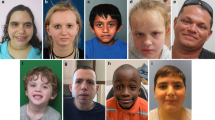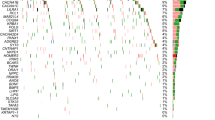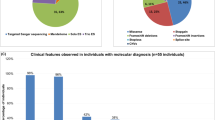Abstract
Mental retardation (MR) is characterized by cognitive impairment with an IQ <70. Many of the major causes are genetically determined and the ∼30% male excess suggests that mutations in genes carried on the X chromosome are disproportionably represented. One such gene, jumonji AT-rich interactive domain 1C (JARID1C) on Xp11.2, has been identified in families with X-linked MR (XLMR), with 18 different mutations reported to date. As part of a systematic resequencing of 720 genes in 208 XLMR families of the International Genetic of Learning Disability (IGOLD) consortium, two novel nucleotide changes in the JARID1C coding region were identified, with the nucleotide changes segregating with the disease phenotype in the two families. The first mutation is a single-nucleotide insertion in exon 21 (c.3258_3259insC p.K1087fs*43) causing a frameshift and resulting in a premature termination codon (PTC). Such PTC-containing mRNAs are generally degraded by nonsense-mediated mRNA decay (NMD) surveillance, but our results show that this is not the case with this mutation. The other change is a single-nucleotide substitution in exon 12 (c.1160C>A) in a published family with nonsyndromic MR, MRX13. This change occurs in a highly conserved amino acid, with proline (P) being substituted by threonine (T) (p.P544T). Functional analysis shows that this amino-acid substitution compromises both tri- and didemethylase activity of the JARID1C protein. We conclude that the two novel changes impair JARID1C protein function and are disease-causing mutations in these families.
Similar content being viewed by others
Log in or create a free account to read this content
Gain free access to this article, as well as selected content from this journal and more on nature.com
or
References
Kortschak RD, Tucker PW, Saint R : ARID proteins come in from the desert. Trends Biochem Sci 2000; 25: 294–299.
Jensen LR, Amende M, Gurok U et al: Mutations in the JARID1C gene, which is involved in transcriptional regulation and chromatin remodeling, cause X-linked mental retardation. Am J Hum Genet 2005; 76: 227–236.
Kim TD, Shin S, Janknecht R : Repression of Smad3 activity by histone demethylase SMCX/JARID1C. Biochem Biophys Res Commun 2008; 366: 563–567.
Iwase S, Lan F, Bayliss P et al: The X-linked mental retardation gene SMCX/JARID1C defines a family of histone H3 lysine 4 demethylases. Cell 2007; 128: 1077–1088.
Tahiliani M, Mei P, Fang R et al: The histone H3K4 demethylase SMCX links REST target genes to X-linked mental retardation. Nature 2007; 447: 601–605.
Abidi FE, Holloway L, Moore CA et al: Mutations in JARID1C are associated with X-linked mental retardation, short stature and hyperreflexia. J Med Genet 2008; 45: 787–793.
Adegbola A, Gao H, Sommer S, Browning M : A novel mutation in JARID1C/SMCX in a patient with autism spectrum disorder (ASD). Am J Med Genet A 2008; 146A: 505–511.
Santos C, Rodriguez-Revenga L, Madrigal I, Badenas C, Pineda M, Mila M : A novel mutation in JARID1C gene associated with mental retardation. Eur J Hum Genet 2006; 14: 583–586.
Tzschach A, Lenzner S, Moser B et al: Novel JARID1C/SMCX mutations in patients with X-linked mental retardation. Hum Mutat 2006; 27: 389.
Kerr B, Gedeon A, Mulley J, Turner G : Localization of non-specific X-linked mental retardation genes. Am J Med Genet 1992; 43: 392–401.
Tarpey P, Smith R, Pleasance E et al: A systematic, large-scale resequencing screen of the X chromosome coding exons in mental retardation. Nat Genet 2009; 41: 535–543.
Isken O, Maquat LE : The multiple lives of NMD factors: balancing roles in gene and genome regulation. Nat Rev Genet 2008; 9: 669–712.
Shi X, Hong T, Walter KL et al: ING2 PHD domain links histone H3 lysine 4 methylation to active gene repression. Nature 2006; 442: 96–99.
Wysocka J, Swigut T, Xiao H et al: A PHD finger of NURF couples histone H3 lysine 4 trimethylation with chromatin remodelling. Nature 2006; 442: 86–90.
Berkovic SF, Heron SE, Giordano L et al: Benign familial neonatal-infantile seizures: characterization of a new sodium channelopathy. Ann Neurol 2004; 55: 550–557.
Cook Jr EH, Stein MA, Krasowski MD et al: Association of attention-deficit disorder and the dopamine transporter gene. Am J Hum Genet 1995; 56: 993–998.
Heron SE, Phillips HA, Mulley JC et al: Genetic variation of CACNA1H in idiopathic generalized epilepsy. Ann Neurol 2004; 55: 595–596.
Heron SE, Khosravani H, Varela D et al: Extended spectrum of idiopathic generalized epilepsies associated with CACNA1H functional variants. Ann Neurol 2007; 62: 560–568.
Nelson KB, Grether JK, Croen LA et al: Neuropeptides and neurotrophins in neonatal blood of children with autism or mental retardation. Ann Neurol 2001; 49: 597–606.
Weiss LA, Escayg A, Kearney JA et al: Sodium channels SCN1A, SCN2A and SCN3A in familial autism. Mol Psychiatry 2003; 8: 186–194.
Delbridge ML, Longepied G, Depetris D et al: TSPY, the candidate gonadoblastoma gene on the human Y chromosome, has a widely expressed homologue on the X-implications for Y chromosome evolution. Chromosome Res 2004; 12: 345–356.
Yi L, Hao Z, Yang T, Wang S, Xing B, Xu Y : cDNA cloning, bioinformatic and tissue-specific expression analysis of porcine JARID1C gene. J Genet Genomics 2007; 34: 1088–1096.
Author information
Authors and Affiliations
Corresponding author
Rights and permissions
About this article
Cite this article
Rujirabanjerd, S., Nelson, J., Tarpey, P. et al. Identification and characterization of two novel JARID1C mutations: suggestion of an emerging genotype–phenotype correlation. Eur J Hum Genet 18, 330–335 (2010). https://doi.org/10.1038/ejhg.2009.175
Received:
Revised:
Accepted:
Published:
Issue date:
DOI: https://doi.org/10.1038/ejhg.2009.175
Keywords
This article is cited by
-
Expanding the genetics and phenotypic spectrum of Lysine-specific demethylase 5C (KDM5C): a report of 13 novel variants
European Journal of Human Genetics (2023)
-
A female case with novel KDM5C heterozygous variation presenting with Claes-Jensen type-like phonotype
BMC Neurology (2022)
-
Peripheral blood epi-signature of Claes-Jensen syndrome enables sensitive and specific identification of patients and healthy carriers with pathogenic mutations in KDM5C
Clinical Epigenetics (2018)
-
Spermatogenic failure and the Y chromosome
Human Genetics (2017)
-
Xp11.2 microduplications including IQSEC2, TSPYL2 and KDM5C genes in patients with neurodevelopmental disorders
European Journal of Human Genetics (2016)



